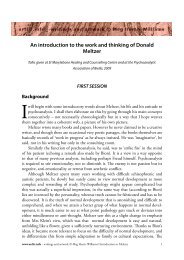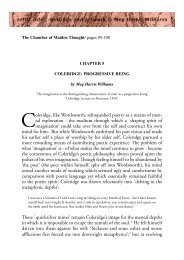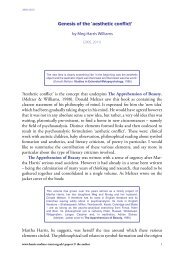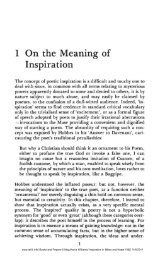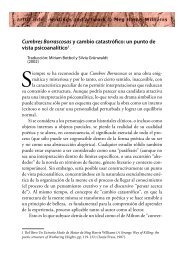Psychoanalytical observation: the artistic analogy - Artlit
Psychoanalytical observation: the artistic analogy - Artlit
Psychoanalytical observation: the artistic analogy - Artlit
Create successful ePaper yourself
Turn your PDF publications into a flip-book with our unique Google optimized e-Paper software.
A dream-reader is by definition a type of artist, or symbol-maker: someonewho “can intuit <strong>the</strong> significant potential of a form” (Langer 1942, p.223; 1953, p. 390). Reading <strong>the</strong> dream – of whatever kind – is a far morecomplex process than merely interpreting it. Looking, reading, and listening,are complex processes that entail abandoning <strong>the</strong> personal intellectual“possessions” of memory and desire (Bion 1970, p. 43) in order to achievea more accurate picture of in <strong>the</strong> feeling-present.‘Reading’ is one of those terms that Bion adjures us to consider morecarefully, like ‘experience’ or ‘thinking’ or ‘knowing’, in order to restore itsvalue:It is as well to be reminded by <strong>the</strong> poet Herman Melville that <strong>the</strong>re are manyways of reading books, but very few of reading <strong>the</strong>m properly – that is, withawe. How much <strong>the</strong> same is it true of reading people. (Bion 1985, p. 241)How do we ‘read’ books, people, paintings, music, ‘with awe’? that is ina way that involves being internally affected by <strong>the</strong> aes<strong>the</strong>tic object beyondour control, as Meltzer puts it, or that entails an intersection with O, <strong>the</strong>Platonic realm of unknown ideas, as Bion puts it.A special type of identification with <strong>the</strong> aes<strong>the</strong>tic object is required inorder to ‘read’ <strong>the</strong> impact on one’s own mind. It is a problem that applieswith equivalent force to <strong>the</strong> situation of <strong>the</strong> analyst, or <strong>the</strong> poetry-reader,or <strong>the</strong> baby-observer. In <strong>the</strong> field of art criticism Adrian Stokes <strong>the</strong> artcritic explains how, in our close viewing of art, we find ourselves “in touchwith a process that seems to be happening on our looking, a process towhich we are joined as if to an alternation of part-objects” (1965, p. 26).He described this projective-introjective dialogue as “envelopment andincorporation”. The projective movements are communicative, questingones, not omnipotent ones designed to control <strong>the</strong> object. In this way wecome to hold <strong>the</strong> feel of a dream that would “o<strong>the</strong>rwise be forgotten”. Aswe observe <strong>the</strong> dream, a container forms to hold our <strong>observation</strong>s, providedwe maintain our orientation to <strong>the</strong> aes<strong>the</strong>tic object. As Bion puts it,we identify with O – not with ei<strong>the</strong>r mouth or breast alone but with <strong>the</strong>link between <strong>the</strong>m that points to O and makes contact with <strong>the</strong> underlyingIdea of <strong>the</strong> situation.Bion sees this container as forming within a space that is created byscientific, <strong>artistic</strong> and religious vertices operating in unison, provided <strong>the</strong>www.artlit.info - writings and artwork © Meg Harris Williams/ Psychoanalytic <strong>observation</strong> 3



